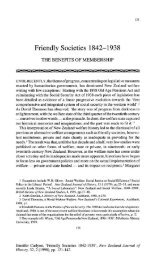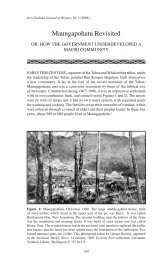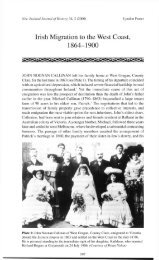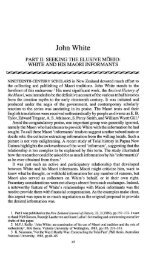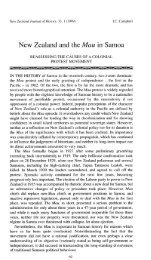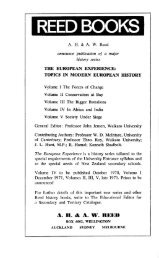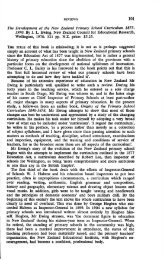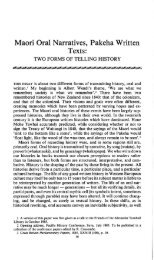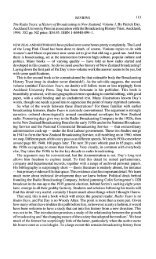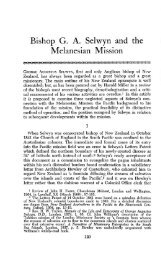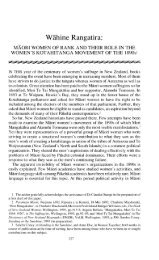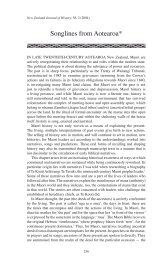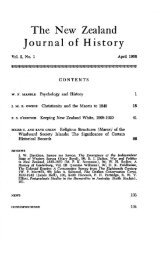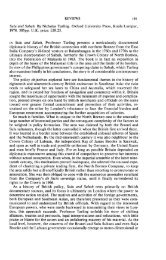Some Reasons for the Failure of the Roman Catholic Mission to the ...
Some Reasons for the Failure of the Roman Catholic Mission to the ...
Some Reasons for the Failure of the Roman Catholic Mission to the ...
Create successful ePaper yourself
Turn your PDF publications into a flip-book with our unique Google optimized e-Paper software.
ROMAN CATHOLIC MISSION TO THE MAORIS, 1838-1860 173<br />
In 1850 <strong>the</strong>re were nine stations, each with a permanent missionary; 24<br />
after that year <strong>the</strong> number <strong>of</strong> permanent, full-time missionaries decreased.<br />
Despite this shortage, Pompallier had spaced out his stations<br />
in an attempt <strong>to</strong> cover a wide area. Fa<strong>the</strong>r Borjon recorded that in his<br />
district (round Ro<strong>to</strong>rua) it would take at least a month <strong>to</strong> visit successively<br />
all <strong>the</strong> little villages. 25 The Waika<strong>to</strong> missionary served <strong>the</strong> entire<br />
area between Matamata and nor<strong>the</strong>rn Taranaki. Fa<strong>the</strong>r Lampila, stationed<br />
at Whakatane, travelled as far as sou<strong>the</strong>rn Hawke's Bay almost<br />
every year, and Fa<strong>the</strong>r Comte, at Otaki, visited both Wanganui and <strong>the</strong><br />
Wairarapa. 26 Besides this, when a station was vacant, <strong>the</strong> neighbouring<br />
missionary was expected <strong>to</strong> keep an eye on it, which meant even more<br />
travelling. In 1840 Pompallier had himself written that at least one<br />
missionary was needed <strong>for</strong> each tribe <strong>of</strong> any size if <strong>the</strong> natives were <strong>to</strong><br />
be kept firm in <strong>the</strong> faith. 27 Although not numerous, <strong>the</strong> early missionaries,<br />
who were all Marists, were devoted <strong>to</strong> <strong>the</strong>ir task, and could have<br />
accomplished more with better direction.<br />
The mobility <strong>of</strong> <strong>the</strong> <strong>Catholic</strong> missionary, and <strong>the</strong> lack <strong>of</strong> continuity<br />
in <strong>the</strong> mission stations which resulted from his comparative freedom<br />
<strong>to</strong> move round, have already been mentioned. By 1850 things had<br />
settled down, and several stations which had changed hands rapidly<br />
at first had kept <strong>the</strong>ir missionaries <strong>for</strong> six, seven or eight years. But in<br />
1850 <strong>the</strong>re was a major reorganisation in <strong>the</strong> mission: <strong>the</strong> Marist<br />
Fa<strong>the</strong>rs were transferred <strong>to</strong> <strong>the</strong> newly created diocese <strong>of</strong> Welling<strong>to</strong>n<br />
under Bishop Viard (himself a Marist), while Pompallier, now in<br />
charge <strong>of</strong> Auckland (<strong>the</strong> nor<strong>the</strong>rn two-thirds <strong>of</strong> <strong>the</strong> North Island), had<br />
<strong>to</strong> find an entirely new set <strong>of</strong> priests. The reason <strong>for</strong> <strong>the</strong> withdrawal<br />
<strong>of</strong> <strong>the</strong> Marists was a disagreement between Bishop Pompallier and <strong>the</strong><br />
Superior <strong>of</strong> <strong>the</strong> Marist Order in France. It is worth mentioning in<br />
passing that such a major upheaval would never have been attempted<br />
by <strong>the</strong> Church <strong>Mission</strong>ary Society, and was only made possible by <strong>the</strong><br />
self-abnegation <strong>of</strong> <strong>the</strong> <strong>Catholic</strong> priests, by <strong>the</strong>ir lack <strong>of</strong> worldly ties and<br />
<strong>the</strong>ir habit <strong>of</strong> obedience. The results were little less than disastrous <strong>for</strong><br />
<strong>the</strong> <strong>Catholic</strong> mission <strong>to</strong> <strong>the</strong> Maoris.<br />
In all <strong>the</strong> established mission stations <strong>the</strong>re was a break in continuity,<br />
and it came at a very critical time, since by <strong>the</strong> fifties <strong>the</strong> novelty <strong>of</strong><br />
Christianity was beginning <strong>to</strong> wear <strong>of</strong>f. Pompallier did succeed in<br />
obtaining about a dozen new priests <strong>for</strong> <strong>the</strong> Auckland diocese. 28 They<br />
24 First 5 <strong>of</strong> above, and Whakatane, Ro<strong>to</strong>rua, Rangiaowhia, Otaki. Evidence<br />
<strong>for</strong> <strong>the</strong> continuous existence <strong>of</strong> <strong>the</strong> mission stations is fragmentary. See my<br />
M.A. <strong>the</strong>sis, Jane Thomson, 'The <strong>Roman</strong> <strong>Catholic</strong> <strong>Mission</strong> in New Zealand<br />
1838-1870', Vic<strong>to</strong>ria University <strong>of</strong> Welling<strong>to</strong>n, 1966, pp. 152-60, 169-79, 206-16.<br />
25 Borjon <strong>to</strong> Colin, 21 January 1842, Annales des missions, p. 113.<br />
26 Pezant, pp. 8 ff. Kay Mooney, The Work is Great: Napier <strong>Catholic</strong><br />
Parish 1859-1960, [Napier?!, 1960, p. 9 (quotes records <strong>of</strong> baptisms 1844-50).<br />
Colenso <strong>to</strong> CMS, June 1846, William Colenso, Letters 1834-1853, MS, Hocken<br />
Library, p. 138. Anon., Sketch <strong>of</strong> <strong>the</strong> Work <strong>of</strong> <strong>the</strong> <strong>Catholic</strong> Church <strong>for</strong> <strong>the</strong> Last<br />
Half-Century, in <strong>the</strong> Archdiocese <strong>of</strong> Welling<strong>to</strong>n, Welling<strong>to</strong>n, 1887, p. 22.<br />
27 Pompallier <strong>to</strong> Colin, 14 May 1840, Annales de la propagation de la foi,<br />
XIII, 49.<br />
28 ibid., XXI, 445.



